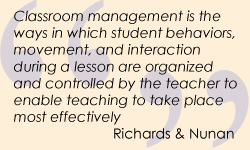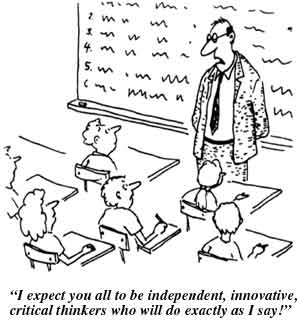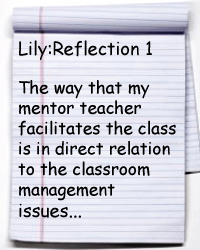 Classroom Management in the SL/FL Classroom
Classroom Management in the SL/FL Classroom
Jin and Lily realize that their field experiences will allow them to practice some classroom management strategies, but they also see that the second language classroom can pose some different challenges that the mainstream classroom. This section will focus on how the SL classroom differs from that in the mainstream classroom in regards to management as well as offering some strategies for managing the second language classroom. |
|
 A well-managed class is one in which time is well used and in which there are fewer distractions resulting from poor discipline or a poorly structured lesson. Classroom management, however, is not an easily explained subject that can be taught in university courses without some inferences being made by observing live teachers in classrooms over a period of time and in different contexts. Needless to say, classroom management cannot be reduced to few discrete components to be imparted to new teachers in short, simplified training sessions.
A well-managed class is one in which time is well used and in which there are fewer distractions resulting from poor discipline or a poorly structured lesson. Classroom management, however, is not an easily explained subject that can be taught in university courses without some inferences being made by observing live teachers in classrooms over a period of time and in different contexts. Needless to say, classroom management cannot be reduced to few discrete components to be imparted to new teachers in short, simplified training sessions.
How does classroom management in the SL classroom differ from that in the mainstream classroom?
Possible Challenges |
Possible solutions |
More oral interaction activities call for more structured environments |
Strategic teacher planning and preparation. |
Using the TL in the class can lead to less explicit directions, instructions or expectations. |
Teachers can use visual cues and supports to clarify expectations. |
Language classes are often treated as secondary courses (or optional courses) that are not taken as seriously as other courses. |
Advocacy of the importance of SL acquisition. |
The difficulty of subject matter can lead to a decrease in student motivation. |
Scaffolding can be used to offer student supports at every stage of the learning process. |
back to top
What are some strategies for managing my second language classroom?
 Dr. Robert Kizlik offers four fundamental points to think about in order to create an Effective Classroom Management Context.
Dr. Robert Kizlik offers four fundamental points to think about in order to create an Effective Classroom Management Context.
1. Know what you want and what you don't want.
2. Show and tell your students what you want.
3. When you get what you want, acknowledge the specific bahaviour with personal feedback.
4. When you get something else, act quickly and appropriately.
Specific Strategies
|
|
Arrange the learning milieu in a way that facilitates student learning while at the same time allowing the teacher to observe and control the class. This will differ from class to class and from year to year. |
| Be Prepared and plan with students in mind | Always plan ahead and have more activities than necessary. Plan with students in mind; when students are bored, disengaged or have nothing to do, they are more likely to be disruptive. |
| Set expectations | From the very beginning of the year, let the students know what is expected. You can even involve the students in setting expectations which will allow them to take ownership of their behaviour. |
| Use names and proximity | When students are being disruptive, let them know that you know without singling them out or embarrassing them. |
| Acknowledge positive behaviour | Students will be more likely to behave appropriately if they are recognized for it. |
Are there any specific management strategies I should consider for ELL students?
Due to differences in language and culture, some ELL students might be misperceived as being disruptive or non-responsive in regards to managing the classroom. Dr. Robert Kizlik offers some tips that might be considered in regards to management and ELL students in the mainstream classroom.
- ELL students come from a variety of backgrounds, even in the same country (for example schooled, unschooled, Americanized, etc.) This can lead to different expectations or patterns of behavior.
- ELL students are not stupid and they can hear what is being said. They just don't necessarily understand the language or culture, yet.
- It is easy to misunderstand body language and certain behaviors (for example, eye contact, gestures, etc.)
- Don't assume they understand something just because it seems simple to you. Simplify, boil it down.
- Even when they have lost their accent, they often misunderstand common words and phrases.
-
Correct repeated patterns or mistakes.
back to top
Other points to consider:
Classroom management is not an isolated part of teaching but rather connected to many other aspects of how a teacher runs their classroom. Other aspects of teaching that can influence classroom management include, but are not limited to:
The Learning Milieu and Classroom Environment

Extensive Information on Classroom Management
http://www.ingilish.com/classroommanagement.htm
Curran, M. Linguistic Diversity and Classroom Management
http://findarticles.com/p/articles/mi_m0NQM/is_4_42/ai_111506831/


 In their reflections both Jin and Lily mention classroom management and how their mentor teachers facilitate the class. One of the first things Jin notices in his observation week is how well his mentor teacher is able to manage the class and he expresses some fears about doing so himself. In Lily's case she observes that her mentor teacher's management style has a lot to do with the way the students behave. Lily is trying to decide if the her mentor teacher is reacting to the students or if the students are reacting to the teacher. In both cases the student teachers express some anxieties about management. This is common among beginning teachers and although there are courses offered by many teacher education programs, classroom management remains a difficult subject to learn solely through theoretical classes.
In their reflections both Jin and Lily mention classroom management and how their mentor teachers facilitate the class. One of the first things Jin notices in his observation week is how well his mentor teacher is able to manage the class and he expresses some fears about doing so himself. In Lily's case she observes that her mentor teacher's management style has a lot to do with the way the students behave. Lily is trying to decide if the her mentor teacher is reacting to the students or if the students are reacting to the teacher. In both cases the student teachers express some anxieties about management. This is common among beginning teachers and although there are courses offered by many teacher education programs, classroom management remains a difficult subject to learn solely through theoretical classes. 

